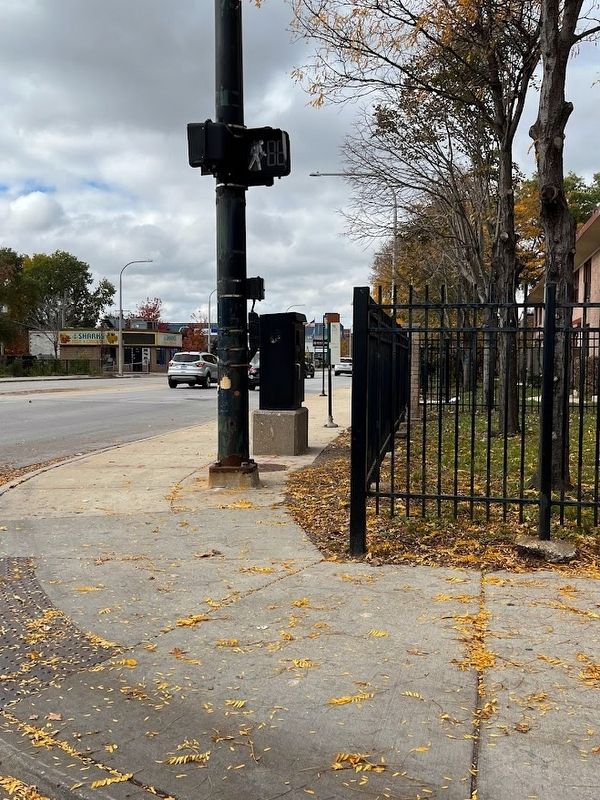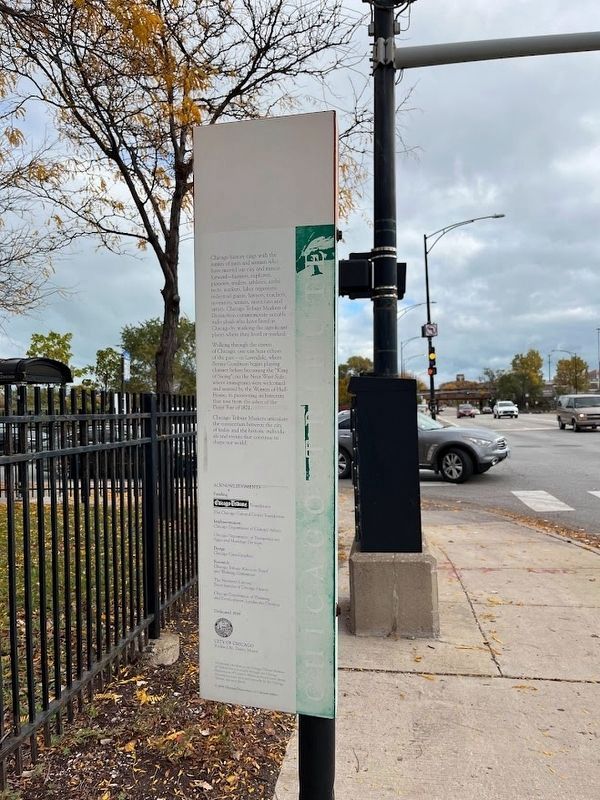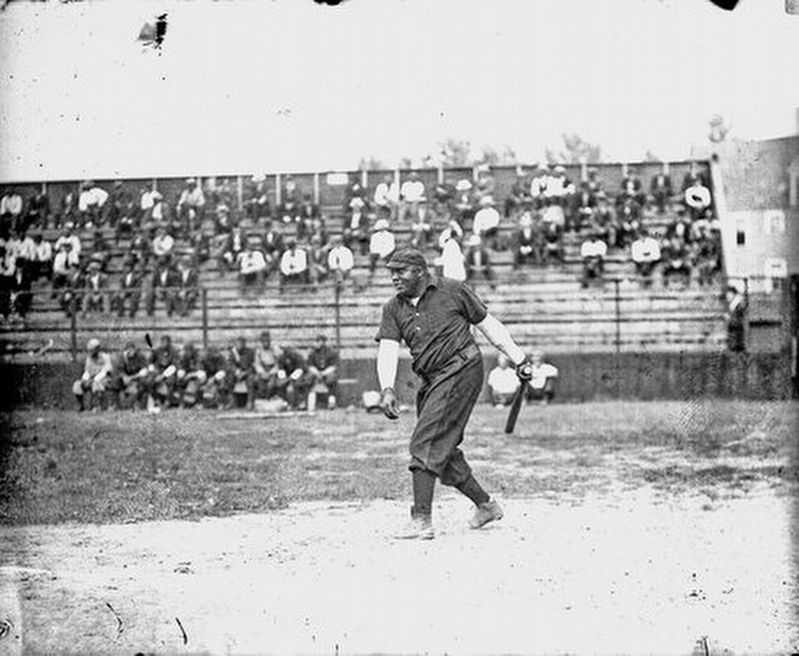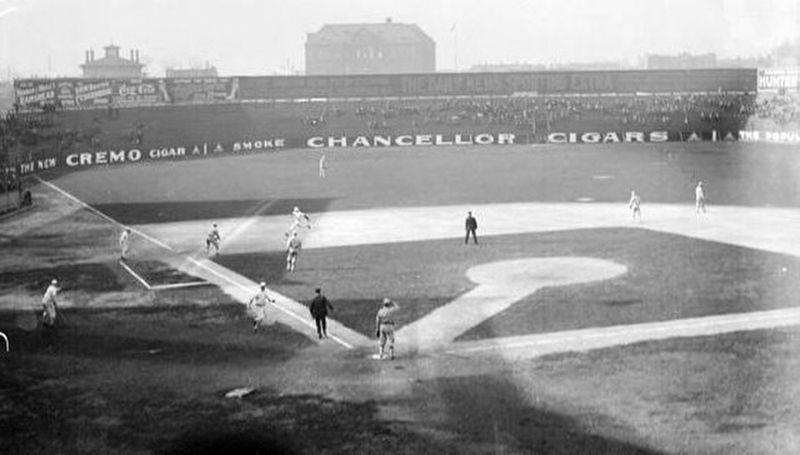South Side in Chicago in Cook County, Illinois — The American Midwest (Great Lakes)
Andrew "Rube" Foster
Baseball player and owner (1879-1930)
— Chicago Tribute —
In 1911, in partnership with white saloonkeeper John Schorling, he founded the Chicago American Giants, which became one of the greatest teams in black baseball history. Player, manager, and owner, Foster insisted that his team play “smart baseball”—fast and aggressive with bunts, steals, hit-and-runs and crafty pitching—which made white baseball seem very sedate. He led his team to Negro League championships in 1914, 1915, and 1917. The Chicago American Giants played at Schorling’s Park, located here at 39th Street and Wentworth Avenue. The Chicago White Sox also played here before moving to Comiskey Park.
In 1920 Foster created the Negro National League with several other owners. The NNL placed black baseball on a solid footing and gained Foster the reputation of being “the father of black baseball.” His Giants won pennants in 1920, 1921, and 1922. The NNL thrived until 1930, the year of Foster’s death. In 1981 Rube Foster was elected to the Baseball Hall of Fame.
Erected 1999 by City of Chicago.
Topics and series. This historical marker is listed in these topic lists: African Americans • Sports. In addition, it is included in the Baseball Hall of Famers, and the Chicago Tribute series lists. A significant historical year for this entry is 1903.
Location. 41° 49.427′ N, 87° 37.894′ W. Marker is in Chicago, Illinois, in Cook County. It is in the South Side. Marker is at the intersection of Pershing Road and Wentworth Avenue, on the right when traveling west on Pershing Road. The marker is a few yards west of the intersection of Pershing (39th Street) and Wentworth, which runs parallel to the Dan Ryan Expressway (I-90), in front of the Wentworth Gardens housing project. It's about ½ mile from Guaranteed Rate Field, home of the Chicago White Sox baseball team. Touch for map. Marker is in this post office area: Chicago IL 60609, United States of America. Touch for directions.
Other nearby markers. At least 8 other markers are within walking distance of this marker. Chicago Bee Building (approx. 0.4 miles away); Overton Hygienic Building (approx. 0.4 miles away); James R. Thompson (approx. half a mile away); Comiskey Park Project Labor Agreement (approx. half a mile away); Carlton Fisk (approx. half a mile away); Mark Buehrle
(approx. half a mile away); Jackie Robinson (approx. half a mile away); Billy Pierce (approx. half a mile away). Touch for a list and map of all markers in Chicago.
More about this marker. The marker is severely faded both on the front and the back. Rube Foster's name, life span and what he is known for is completely unreadable in the red section at the top and has been ascertained from the Chicago Tribute website. The words Chicago Tribute that are supposed to run down the side of the marker facing the street have also disappeared. Schloring's Field, referenced on the sign, was located here, on 39th between Wentworth and Princeton; the site today is Wentworth Gardens, a Chicago Housing Authority development.
Regarding Andrew "Rube" Foster. As a star pitcher, Andrew "Rube" Foster was credited with inventing the screwball pitch. As owner and manager of the Chicago American Giants, he led one of the most successful Black teams of the early 1900s. And as the driving force behind the creation of the Negro National League in 1920, he is known as the "father of black baseball."
Schloring's Field, originally known as South Side Park, was a 15,000-seat
baseball stadium that sat on 39th Street (Pershing) between Wentworth and Princeton, at the site of this marker. It opened in 1900 as the first home of the Chicago White Sox, a founding member of the American League. In June of 1910, the White Sox played their final game at South Side Park, moving about four blocks north for the much larger steel and concrete Sox Park, which would a few years later be renamed Comiskey Park after the team's owner, Charles Comiskey.
That same year, Foster had taken control of the team he played for, the Chicago Leland Giants, from its owner, Frank Leland. Foster then partnered with John Schloring, a South Side saloon keeper who may have been Charles Comiskey's son-in-law, to allow Foster's newly renamed Chicago American Giants to play its home games in the recently abandoned South Side Park, which would be renamed after Schloring. Throughout the 1910s, Foster's Giants were regularly one of the best Black teams in the country; the style of play based on speed and defense was created in part due to Schloring's Field's spacious dimensions.
In 1920, Foster and seven other Negro League owners formed a professional league for African-American teams, with Foster as its president. Foster's Giants won the first three league championships before being surpassed by the Kansas City Monarchs. The league struggled after Foster's death and stopped
play in the early 1930s. It returned to play in the late 1930s and continued play until 1960.
Foster struggled with deteriorating mental health throughout the final years of his life, and in 1926, he was put into an institution in Kankakee, Illinois, where he died more than four years later at the age of 51. According to contemporary reports, more than 3,000 people attended his funeral in Chicago's Bronzeville neighborhood.
The Giants would play in Schloring's Field through 1940, when the park was badly damaged by a fire. The Giants moved to Comiskey Park in 1941, and the badly damaged Schloring's Field was razed.
Foster was elected into the National Baseball Hall of Fame by its Veterans Committee in 1981. He was the first African-American inducted into the hall of fame primarily as an executive.
Also see . . .
1. Rube Foster, Executive; Class of 1981. Rube Foster's page on the National Baseball Hall of Fame website (Submitted on October 28, 2023, by Sean Flynn of Oak Park, Illinois.)
2. Rube Foster. Rube Foster's page on the Society of American Baseball Research (SABR) website (Submitted on October 28, 2023, by Sean Flynn of Oak Park, Illinois.)
Additional commentary.
1. The text of Rube Foster's Hall of Fame Plaque in Cooperstown, New York
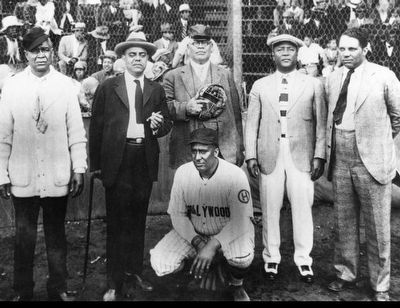
Courtesy of Los Angeles Public Library via California Digital Library
5. Rube Foster
The original description reads: “Men standing behind home plate during a baseball game. Noted baseball pitcher, Rube Foster, is 2nd from right and the man crouching is wearing a ‘Hollywood’ baseball uniform.” While the citation says circa 1929, it is almost certainly several years earlier, considering that Foster was institutionalized in 1926 and stayed there until his death in 1930.
"Rated foremost manager and executive in history of Negro Leagues. Acclaimed top pitcher in Black baseball for nearly a decade in early 1900s. Formed Chicago American Giants in 1911 and built them into Midwest's dominant Black team. In 1920 he organized Negro National League. Headed league and managed Chicago team until retirement following 1926 season."
— Submitted October 28, 2023, by Sean Flynn of Oak Park, Illinois.
Credits. This page was last revised on December 5, 2023. It was originally submitted on October 28, 2023, by Sean Flynn of Oak Park, Illinois. This page has been viewed 94 times since then and 56 times this year. Photos: 1, 2, 3. submitted on October 28, 2023, by Sean Flynn of Oak Park, Illinois. 4. submitted on October 29, 2023, by Sean Flynn of Oak Park, Illinois. 5, 6. submitted on October 28, 2023, by Sean Flynn of Oak Park, Illinois. • Andrew Ruppenstein was the editor who published this page.

